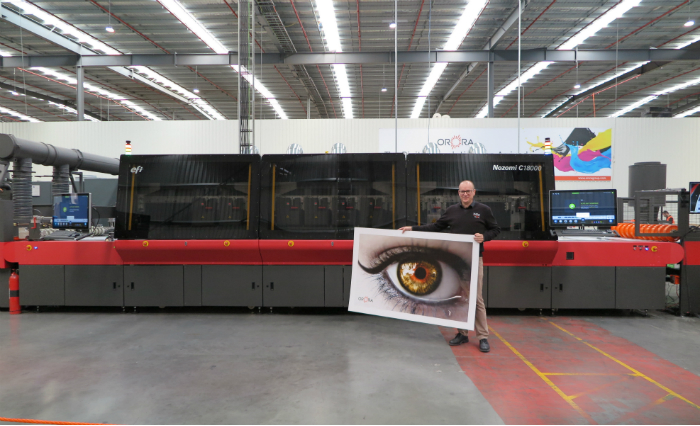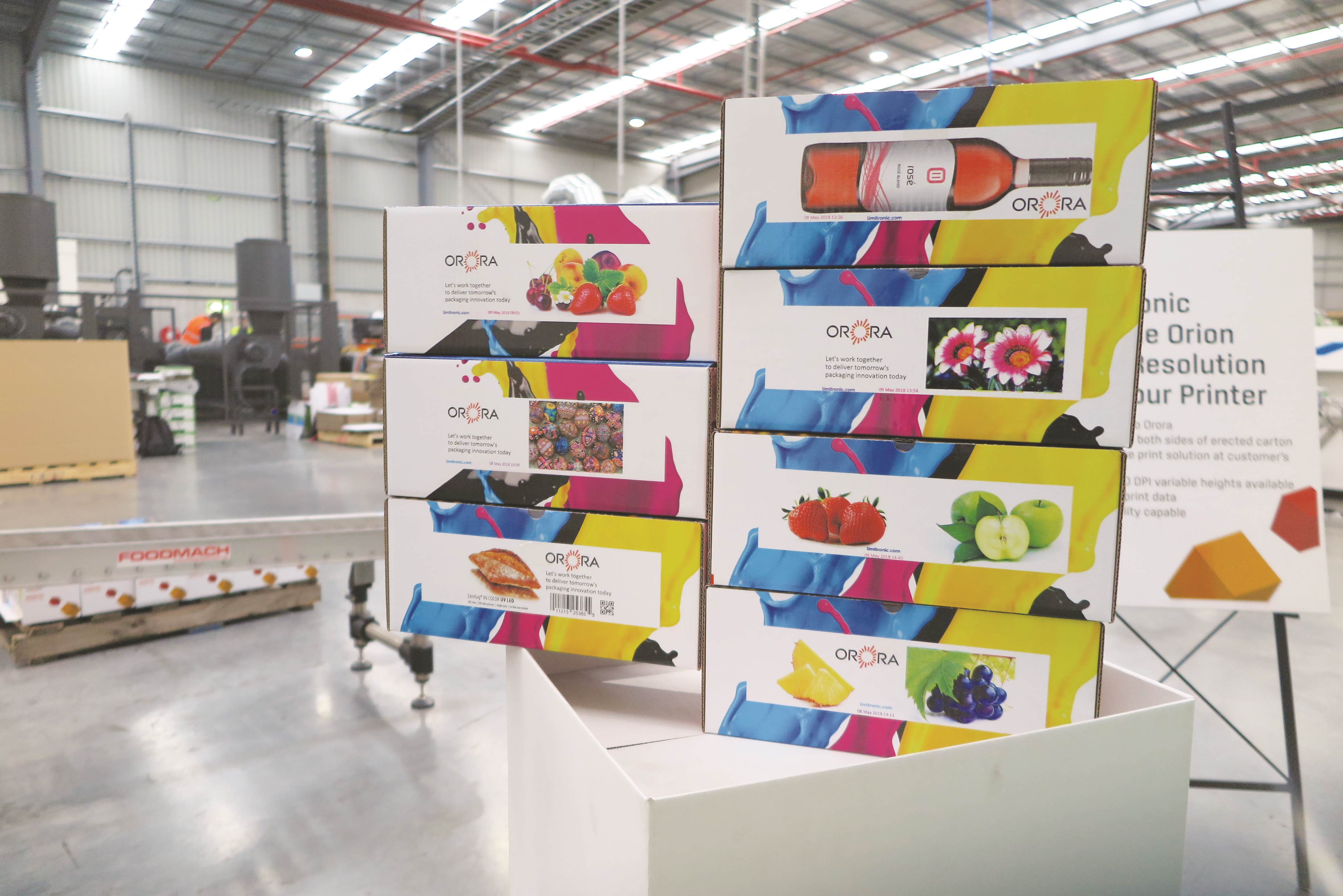
Australian packaging giant Orora showed its new installation of the first EFI Nozomi C180000 digital packaging printer in the country, along with its other recent investments in its business at its Innovation Expo.
The company has committed a massive $100m to upgrade its printing, converting and corrugator assets in Australia.
Visitors to the four day event at its Oakleigh South facility went on factory tours showing the new technology in action, along with seeing presentations from Nigel Garrard, managing director and CEO of Orora, and Brian Lowe, group manager for Orora’s Australian paper and cardboard division, Fibre.
The guest speaker was advertising guru Russell Howcroft. The Expo also featured booths showing a cross-section of Orora’s business, including the company’s beverage business, paper and recycling, its American point-of purchase business Orora Visual and its specialised Innovation and Design team.
Nigel Garrard, director and CEO of Orora says, “Innovation is a key strategic focus for Orora and the Expo offers an unparalleled opportunity to showcase the investments we have made to help our customers stay one step ahead of their competition. By continually investing in our business, we are able to provide customers with total packaging solutions along the entire value chain, from design to manufacturing, and everything in between.
“This is one of the reasons we increased the Orora Global Innovation Initiative by $30m to $75m, as it fosters a culture of innovation within the business and supports investment in the latest machinery, enabling us to develop advanced packaging solutions that will directly benefit our customers.”
Lowe says, “The Expo has been of benefit to employers and customers, so they can understand what we are doing. They are able to spur on ideas from seeing things in operation.”
Orora says the new large format EFI Nozomi delivers magazine quality imagery directly onto corrugated board, and is able to produce cost-effective on-demand and just-in-time jobs. The press prints in six colours, CMYK with violet and orange with a digital interface that reduces set up time, enabling short runs. The company has not disclosed how much the Nozomi was, although it did confirm it cost more than $5m. Its production is said to be accessible to all customers. A second Nozomi is also being installed in one of its US operations.
Lowe, group general manager of Fibre says, “The Nozomi is the most sophisticated machine to print high quality graphics on corrugated cardboard on the market.
“It is part of a broader investment for Orora. Around $100m has been invested in the last two years on Fibre. Orora has spent $45m on innovation.
“The EFI Nozomi covers 97 per cent of the colour gamut. We will also be installing white printing. White, which is not available yet, can be printed onto board for a glossy white finish or it can be printed onto a box, with something else printing on top, increasing colour intensity. The white printing unit will be installed sometime later this year.
“A large portion of the industry will still need to be large brown boxes but there is interest among customers for high quality print.”
Scott Mayer, general manager, Orora Specialty Packaging says, “The feeding section at the moment is quite small. We commissioned and designed a prefeeder. There will be a forklift that will load work into the machine, we are looking to have more automation for the volume of work that we are anticipating. There also will be more automation at the other end as well.
“The Nozomi uses a water based sealant so the ink sits on the coating and is not soaked into the cardboard. It covers around 97 per cent of the colour gamut, which is useful for representing brands and their logos. Effectively all colours will be covered.

Variable print
Mayer says, “With variable print, we will be able to have hundreds of different designs done in one run. We do not yet know how it will be used.”
Lowe says, “Variable print on this scale was not available in the past, there is not a huge pent up demand for it because it just has not existed. The machine has only been running for a week, but there has been a lot of interest. I think markets will open up in randomisation, personalisation and identification, particularly in barcodes, QR codes and other data. I think identification will be big.
“How much of the business will be taken up by variable and digital print, it could be around 10 per cent but we do not know yet. Quality in variable print was not available before, so it is hard to say but I do think there will be a sizeable portion of the business taken up by it.”
Also on display was the Highcon Euclid IIIC laser cutter, a production speed digital cutting and creasing machine, one of two in the world and another first for Australia. Orora says the third generation machine reduces turnaround time with its laser capability, replacing the traditional die cut method, increasing production volume while also reducing the risk of team member injury. The cutter is designed for high volume packaging, operating at 1500 sheets an hour.
Orora was also exhibiting Australia’s first Limitronic Limitag V6 Orion in-line printer, a mobile press able to print high resolution four colour printing on both sides of a carton, along with a Limitronic Compact V5 printer, an Accu-label orbit fruit labelling station, BCS Boxer, Limitag V6 Customprint with a UR10 industrial robot attached and a Ghelfi tray erector, with a no-crush system developed specifically for the fresh produce sector.
The Limitag device with a robot attachment is said to be the first machine of its type, incorporating the four-colour in-line digital printer, while the arm picks up and places box lids, with QR codes on lids directing its allocations onto stacking trays.
The BCS Boxer is said to be able to produce a wide range of carton shapes and sizes from a flat corrugated sheet, capable of making 500-700 boxes an hour. Orora is targeting it towards e-commerce applications with custom made boxes.
Orora says the Accu labeller is able to print in-line at 15 labels per second and uses thin, high-quality bio-degradable paper, with a high wet-strength, designed for wet and fuzzy fruit. The machine is new to Australia, with it already being used by the company in the US.
The Limitronic machines, which deliver high resolution four colour printing, are being made available to install on the sites of Orora’s customers, allowing them to be able to print variable data on boxes in real time and on demand. Orora says its customers only need plain cartons which are then printed on demand, preventing over-ordering of pre-printed boxes and reducing inventory costs.
The Compact V5 offers similar benefits to the Orion V6, but on a reduced scale for smaller jobs.
Lowe says, “We are offering printing on customer’s sites. It takes the complexity out of our business. For example, a customer might have 30 different box lids. Set ups are slow, we have to hold stock and they have to hold stock. This way the customer can print specific information directly onto each lid themselves and it simplifies the whole process.
“The machines have been in the country for about a week. The model for installation with each customer will be varied, it could be dependent on each customer’s needs. They could need one device or all of them or ten of one.”
Scott Mayer of Orora Specialty Packaging says, “The Limitronic machines do inline digital printing and are applied at the end of the production line. It allows for customisation and different designs for specific variants. We can reduce inventory and print just before packaging products. There is flexibility in digital print.”
As part of its investment drive the company also recently invested $42m into expanding its Gawler glass plant in South Australia, expanding the glass bottle forming lines and increasing capacity by approximately 60 million bottles a year. Last year it completed construction on a $23m secondary water treatment plant at its Botany paper mill in Sydney.
The company is also securing a long term power purchasing agreement with global renewable energy provider Pacific Hydro, to supply wind-generated electricity for Orora’s SA operations, including its Gawler glass facility. Under the agreement, Orora will have a long term supply of renewable energy from Clements Gap Wind Farm, for a volume equal to Orora’s total electricity demand in the state.
Garrad says, “Orora operates energy intensive businesses and is continuing to actively investigate a range of options to manage higher energy prices and safeguard supply for the Australian operations.”
In its FY17 results, Orora Australia delivered a 2.3 per cent increase in sales revenue to $2bn from $1.95bn and EBIT (earnings before tax and interest) of $213.6m, a 6.6 per cent increase from $200.4m The company says both Australasian business groups – Fibre Packaging and Beverage – delivered earnings growth despite flat economic conditions and higher input costs.
Orora employs more than 6,700 people across 43 manufacturing plants and 88 distribution sites in seven countries. Across Australia and New Zealand it has 28 manufacturing sites. The ASX listed company demerged from Amcor four years ago and generated revenue in excess of $4bn in FY17.
Comment below to have your say on this story.
If you have a news story or tip-off, get in touch at editorial@sprinter.com.au.
Sign up to the Sprinter newsletter
